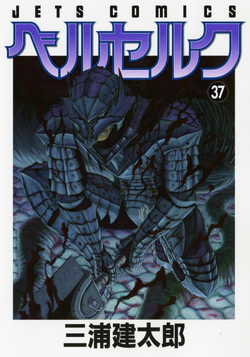No edit summary Tags: Visual edit apiedit |
(SMWPropertyList instead of previous list link) |
||
| (5 intermediate revisions by 4 users not shown) | |||
| Line 1: | Line 1: | ||
| + | [[File:Berserk.png|thumb|250px|[[Berserk]], a popular example of a seinen manga]] |
||
| − | + | '''Seinen''' (青年漫画) is a subset of [[manga]] that is generally targeted at a 18–30 year old male audience, but the audience can be older with some comics aimed at businessmen well into their 40s. In Japanese, the word Seinen means "young man" or "young men" and is not suggestive of sexual matters. (The female equivalent to seinen manga is [[josei]] manga.) |
|
| − | It has a wide variety of art styles and more variation in subject matter, ranging from the avant-garde to the pornographic. Seinen manga is distinguished from shōnen, or boys' manga, by having a stronger emphasis on realism. Because of the emphasis on storyline and character development instead of action, some seinen series are often confused with shōjo, or girls' manga. |
+ | It has a wide variety of art styles and more variation in subject matter, ranging from the avant-garde to the pornographic. Seinen manga is distinguished from [[shōnen]], or boys' manga, by having a stronger emphasis on realism. Because of the emphasis on storyline and character development instead of action, some seinen series are often confused with [[shōjo]], or girls' manga.{{fact}} This is especially true of seinen comedy series such as [[Chobits]], and [[Chi's Sweet Home]], or seinen drama such as [[Twin Spica]]. Other examples of seinen manga include: [[Gantz]], [[Battle Royale]], [[20th Century Boys]], [[Monster]], [[Blame!]], [[Ghost in the Shell]], [[Akira]], [[Berserk]], [[Battle Angel Alita]], [[Hellsing]], [[Neon Genesis Evangelion]], [[Elfen Lied]], and [[Maison Ikkoku]]. |
| + | |||
| ⚫ | A common way to tell if a manga is seinen is by looking at whether or not [[wikipedia:furigana|furigana]] (pronunciation guide) is used over the original kanji text: if there are furigana on all kanji, the title is generally aimed at a younger audience. The title of the magazine it was published in is also an important indicator. Usually Japanese manga magazines with the word "young" in the title ([[Weekly Young Jump]] for instance, contrasted to [[Weekly Shōnen Jump]]) are seinen. Other popular seinen manga magazines include [[Ultra Jump]], [[Afternoon]], and [[Big Comic]]. |
||
| ⚫ | A common way to tell if a manga is seinen is by looking at whether or not furigana is used over the original kanji text: if there are furigana on all kanji, the title is generally aimed at a younger audience. The title of the magazine it was published in is also an important indicator. Usually Japanese manga magazines with the word "young" in the title ([[Weekly Young Jump]] for instance) are seinen. Other popular seinen manga magazines include Ultra Jump, Afternoon, and Big Comic. |
||
==See also== |
==See also== |
||
*[[Shōnen]]: Manga intended for boys |
*[[Shōnen]]: Manga intended for boys |
||
| Line 9: | Line 11: | ||
*[[Josei]]: Manga intended for young women |
*[[Josei]]: Manga intended for young women |
||
*[[Kodomo]]: Manga intended for children |
*[[Kodomo]]: Manga intended for children |
||
| + | *{{SMWPropertyList|Demographic|Seinen|List of Seinen series}}<!--{{Drilldown}} doesn't work for searching on Demographic--> |
||
| − | *{{Drilldown|List of Seinen series|Series|q=Genre=Seinen|q=Tags=Seinen}} |
||
{{Wikipedia|Seinen manga}} |
{{Wikipedia|Seinen manga}} |
||
[[Category:Terminology]] |
[[Category:Terminology]] |
||
| − | [[Category: |
+ | [[Category:Demographics]] |
Revision as of 23:56, 24 January 2019

Berserk, a popular example of a seinen manga
Seinen (青年漫画) is a subset of manga that is generally targeted at a 18–30 year old male audience, but the audience can be older with some comics aimed at businessmen well into their 40s. In Japanese, the word Seinen means "young man" or "young men" and is not suggestive of sexual matters. (The female equivalent to seinen manga is josei manga.)
It has a wide variety of art styles and more variation in subject matter, ranging from the avant-garde to the pornographic. Seinen manga is distinguished from shōnen, or boys' manga, by having a stronger emphasis on realism. Because of the emphasis on storyline and character development instead of action, some seinen series are often confused with shōjo, or girls' manga.[citation needed] This is especially true of seinen comedy series such as Chobits, and Chi's Sweet Home, or seinen drama such as Twin Spica. Other examples of seinen manga include: Gantz, Battle Royale, 20th Century Boys, Monster, Blame!, Ghost in the Shell, Akira, Berserk, Battle Angel Alita, Hellsing, Neon Genesis Evangelion, Elfen Lied, and Maison Ikkoku.
A common way to tell if a manga is seinen is by looking at whether or not furigana (pronunciation guide) is used over the original kanji text: if there are furigana on all kanji, the title is generally aimed at a younger audience. The title of the magazine it was published in is also an important indicator. Usually Japanese manga magazines with the word "young" in the title (Weekly Young Jump for instance, contrasted to Weekly Shōnen Jump) are seinen. Other popular seinen manga magazines include Ultra Jump, Afternoon, and Big Comic.
See also
- Shōnen: Manga intended for boys
- Shōjo: Manga intended for girls
- Josei: Manga intended for young women
- Kodomo: Manga intended for children
- List of Seinen series
